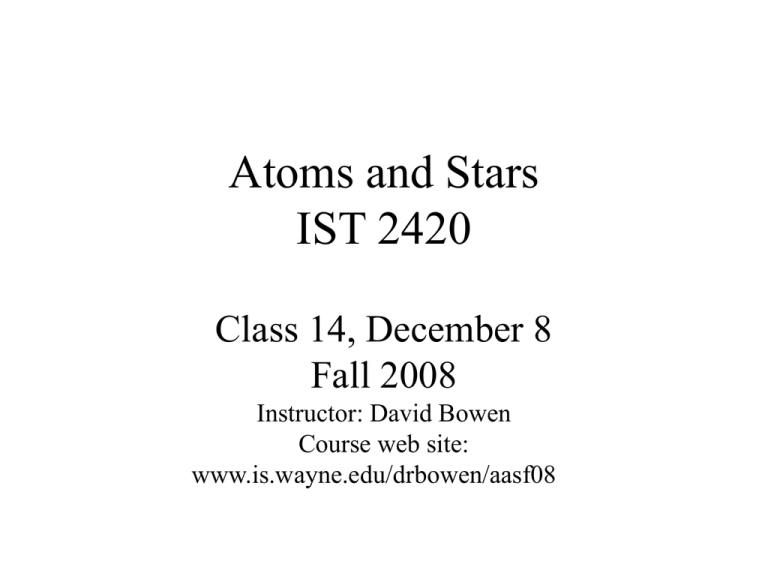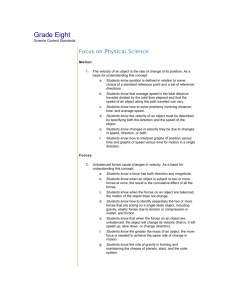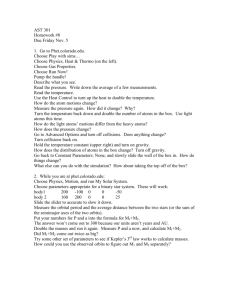Notes for Class 14, December 8
advertisement

Atoms and Stars IST 2420 Class 14, December 8 Fall 2008 Instructor: David Bowen Course web site: www.is.wayne.edu/drbowen/aasf08 Agenda • Assignments, passbacks, initial signin sheet • Class information o Email if much work will be late • • • • Review of readings Updating the course Emphasizing main points one more time Review for Final 12/08/08 Atoms and Stars, Class 14 2 Upcoming … • Tonight, December 8 (last regular class) o Review of Readings o Review for Final Exam o Due: all work to count in regular grade • Work turned in after this class will count towards a Change of Grade after the regular grades come out • Final Exam: next Monday, December 15 o Nothing that night but the Final Exam 12/08/08 Atoms and Stars, Class 14 3 Course Grades • If you are turning a bunch of work in at the end, I may not get it graded in time for the regular grades (see the Syllabus). • If this is you (turning it in late), what grade do you want for the regular grade? D, F, W, I • Email me to let me know – otherwise it’s my decision. 12/08/08 Atoms and Stars, Class 14 4 Your Current Status • Grades I have for you: o Online Grade Report, link off the course web site (see first slide) o Enter first name, last name, password the get report • Grade you are headed for: o Grade What-If on course web site • Ask for help with these if you are having problems 12/08/08 Atoms and Stars, Class 14 5 Opportunities for Q & A • Tonight during the Review Session • Day of the Final, Monday December 15, 5 – 6 PM (normal office hours) in the regular classroom (122 Cohn) • Call, email, set up an appointment • IM to WSU web guy 12/08/08 Atoms and Stars, Class 14 6 ths 16 on the Final (Q1) • Doing the math for converting 16ths (inches, ounces) to decimal (inches, pounds) o If this type of problem is on the Final, there will also be a table of all divisions by 16, with a few non-16ths extras thrown in • 1/16 = .0625, 2/16 = .1250, 3/16 = .1875, 3/7 = .4286, 4/16 = .2500, etc. o So the result of the division will be there, but you will have to know what you are looking for. 12/08/08 Atoms and Stars, Class 14 7 Makeup for Final Exam • Let me know by email that you want a makeup, within 24 hours after the Final (University regulation) • Date / Time, building and room to be settled by email. 12/08/08 Atoms and Stars, Class 14 8 Experiment 7 (Specific Gravity) • Specific Gravity o Ratio of weight of a given volume of a substance (e.g. wood, iron) divided by weight of same volume of water o A property of the substance • Conclusions: o Volume of displaced water = volume of object (Archimedes) 12/08/08 Atoms and Stars, Class 14 9 Experiment 7 • Conclusions from experiments: o Volume of displaced water = volume of object (Archimedes) o Specific Gravity greater than 1: object sinks in water o Specific Gravity less than 1: object floats in water o For an object that floats in water, weight of displaced water = object’s weight (Archimedes) 12/08/08 Atoms and Stars, Class 14 10 Experiment 7 • Conclusions from experiments: o For an object that floats in water, fraction underwater = Specific Gravity o For an object that sinks in water, weight of object in water + weight of displaced water = object’s weight in air o If Specific Gravity of object less that the Specific Gravity of a liquid, object floats in that liquid (iron floats in mercury) 12/08/08 Atoms and Stars, Class 14 11 Re-emphasizing Main Points • Two pillars of science o Experiment: makes science reliable • Scientists led astray by logic (Aristotle) and belief (church and geocentrism, Inquisition) • Experiments base science on direct experience o Theory: makes science valuable • Once you have a reliable theory, it tells you the answer in advance, can use it as technology • Two quotes from Copi, Reader Pg 8 12/08/08 Atoms and Stars, Class 14 12 Re-emphasizing Main Points • I have the experiments in this course to: o Give you direct experience o Illustrate experiments described in class o Illustrate social nature of science within the lab groups 12/08/08 Atoms and Stars, Class 14 13 Readings: Global Warming From last week Readings: Global Warming (Q12) • Light comes in to earth from sun o Some absorbed on surface, warming earth and reradiating heat (infrared) radiation o Rest reflected, exits to space o Greenhouse gases in upper atmosphere trap reradiated infrared radiation, some returned and further heats earth • Amount of warming now about 1ºF but projected to rise rapidly o By 2100, projections = 2.5ºF to 11.5ºF (avg 7ºF) 12/08/08 Atoms and Stars, Class 14 15 Atmosphere, Climate and Change by Thomas Graedel and Paul Crutzen, Scientific American Library, 1997. 12/08/08 Atoms and Stars, Class 14 16 New York Times, “Computers Add Sophistication, but Don’t Resolve Climate Debate,” Science Times Pg D3 8/31/04 12/08/08 Atoms and Stars, Class 14 17 Global Warming (cont’d) • Largest effect in Antarctic o Snow reflects the most, sea water the least o Arctic ice disappearing o Polar bears in danger o Eskimos suing US 12/08/08 The New Yorker, cover, 12/12/05 Atoms and Stars, Class 14 18 Global Warming (cont’d) • What to do? Options: o Nothing. Live with it. (Physical and ecosystem consequences not known) • Humans can adapt quickly, natural world cannot – evolution is slow, but humans are free of evolution o Cosmetic actions. Cite uncertainty, call for more research • Will never have 100% certainty • Options: o “Invisible hand” of market • Trade CO2 permits 12/08/08 Atoms and Stars, Class 14 19 Global Warming (cont’d) • Options (cont’d): o Limit CO2 production • Increase energy efficiency, use waste energy, switch to low-carbon fuels (natural gas) away from coal and petroleum o Remove CO2 once it is generated • Sequestration – pressurized underground or under deep ocean o Geoengineering • Stop sunlight from coming to Earth, e.g. by seeding SO2 to form clouds or putting BIG mirrors in orbit 12/08/08 Atoms and Stars, Class 14 20 Global Warming (cont’d) • (DB) Recent poll says US thinks scientists are confused about Global Warming. NOT! o Deliberate confusion caused by industry groups opposed to controls – citing 2 or 3 out of 2,500 12/08/08 Atoms and Stars, Class 14 21 Readings: Icecaps and Hurricanes Evidence for Global Warming: • Thawing icecaps • Coral bleaching • Hurricanes • Melting glaciers • Desertification • Rising sea levels 12/08/08 Atoms and Stars, Class 14 22 DB: That’s not all… • Intergovernmental Panel on Climate Change (IPCC) report 2007 • IPCC: joint organization of climate scientists and government leaders • We can now see the results directly, instead of using computer models • Some areas may see initial benefit, but if there is no end, all areas will suffer 12/08/08 Atoms and Stars, Class 14 23 DB: That’s not all… • Insurance industry raising premiums to account for expected higher damages • Power and auto industries expect regulation, want it soon so they know what to plan for • Report released today on U.S. “National Security and the Threat of Climate Change” • Board of senior (retired) military • Reduced natural resources, so threats to stability • Increased needs for humanitarian aid • New sea lanes to be protected as ice melts 12/08/08 Atoms and Stars, Class 14 24 DB: That’s not all… • Many worldwide resource issues – “the human footprint” o Population (6 billion 9 billion), water (drinking, irrigation, industrial), food, farmland, living in unsafe places, petroleum, trash, development • Managing the human footprint will be a major, continuing issue • I am not predicting disaster – I think we (you) will manage this, but not easy. 12/08/08 Atoms and Stars, Class 14 25 Readings Readings: Knowledge or Certainty Jacob Bronowksi • Absolute certainty is impossible in science o Looking at an object with infrared, then visible, then x-rays should yield greater detail. Infrared is very blurry, visible is pretty good, but x-rays are too high energy to be focused. Perfect detail of “God’s-eye” view is impossible o Statistical uncertainty in measurements - Gauss 12/08/08 Atoms and Stars, Class 14 27 Knowledge or Certainty • 1795 • Science is discussion and argument preceding knowledge • Also Uncertainty Principal 1927 Werner Heisenberg – cannot locate particle exactly o Irreducible uncertainty or fuzzy focus 12/08/08 Atoms and Stars, Class 14 28 Knowledge or Certainty • No practical effect at macroscopic level, but a philosophical problem with The Mechanical Universe and with “The God’s eye view” • But certainty leads to tragedy – Nazis • (DB) Certainty and power combined 12/08/08 Atoms and Stars, Class 14 29 What is Science? Moti Nissani, What Is Science? • Difficult or impossible to give a dictionarytype definition for science • (DB) Working scientists rarely think about the history or philosophy of science • Start with philosophy of Thales – free inquiry 12/08/08 Atoms and Stars, Class 14 30 What Is Science? (cont’d) • Then hypothesis and experiment (Torricelli) • Falsifiability – reason and logic have not been not sufficient to discover the truth in science (DB: belief, either) o But contradiction by experiment does not always mean rejection of hypothesis – can lead to reexamination of experiment or modification of hypothesis o Scientists “on the trail” have personal concerns 12/08/08 Atoms and Stars, Class 14 31 What Is Science? (cont’d) o Scientists “on the trail” have personal concerns • Argument and community lead to progress o Semmelweiss and deaths in maternity ward • • • • • • 12/08/08 Neighboring ward far safer Did priest’s visit scare patients? Washing hands – doctors did dissections beforehand This fixed the problem Profession slow to accept this change Even scientists can be closed-minded, resist change Atoms and Stars, Class 14 32 What Is Science? (cont’d) • Theories unify many hypotheses and experiments o Price is often inaccessibility to non-scientists • Scientists usually not concerned with these issues or with philosophical uncertainty • Science many not be perfect, but it can still be very good • Many use technology but not the scientific foundation 12/08/08 Atoms and Stars, Class 14 33 Physical Science Current Status Physical Science: Current Status • Newton’s Laws, Maxwell’s Equations and similar classical theories (before ~ 1900) describe world we know and see • For things the size of molecules and smaller, need Quantum Mechanics • Very fast, need Special Relativity • Very heavy, need General Relativity • All three have weird things going on 12/08/08 Atoms and Stars, Class 14 35 Relativity • Reminder about what this is about o Computer simulation • Often very difficult to tell whether or not our measurements are in a moving coordinate system o Earth spins on axis, moves around Sun, Sun moves around Galaxy, is Galaxy moving? • Theory of Relativity says we can only tell relative motion, not absolute 12/08/08 Atoms and Stars, Class 14 36 Special Relativity • For fast-moving objects o o o o Max speed = c (speed of light) Objects foreshortened Time slows down But the traveling person says the same about you! o Space and time space-time o E = mc2 light has mass, is bent by gravity 12/08/08 Atoms and Stars, Class 14 37 General Relativity • For very heavy objects o Space and time warp, cause gravity o Perihelion (closest approach to sun) of Mercury’s ellipse not fixed as in Newton’s Laws, but advances 43 seconds of arc per century (observed), other effects in addition o Says light bends twice as much as Special Relativity says, observed 1918 12/08/08 Atoms and Stars, Class 14 38 General Relativity (cont’d) • “Einstein Halo” – light from far galaxy bent by near galaxy • Variation on gravitational lens • 12 found so far • Picture: New York Times, 12/6/05, Pg D4 (Science) 12/08/08 Atoms and Stars, Class 14 39 Quantum Mechanics Two different types of things • Particle (“thing,” “object”) o Examples: baseball, soup can, projectile, star o One location (or center) o Newton’s three laws govern motion • Wave o Examples: waves in water, sound waves, radio waves o Spread out, exists in many places o “Wave Equations” governed motion (not Newton) • Jump to slide 48 12/08/08 Atoms and Stars, Class 14 41 Two different types of things Particle Wave Position: Definite – one position (center) Spread out, no one place Try to catch it – result is: Collision with another: Existence: Get all or none Only get part, if that Pass through each other In something – the “medium” (before Maxwell) 12/08/08 Ricochet, bounce, shatter All by itself Atoms and Stars, Class 14 42 Demonstrations • PhET (Physics Education Technology) http://www.colorado.edu/physics/phet/web-pages/simulations-base.html o Particles: Gas Properties – they bounce o Waves: Sound >> Interference by Reflection • Interference: light peak, dark trough o http://www.colorado.edu/physics/2000/schroedinger/big_interference.html – some areas gray (unlit) • Light: early 1800s, Thomas Young proved light is a wave – “double slit experiment” o http://www.colorado.edu/physics/2000/schroedinger/two-slit2.html o Confine a wave – it spreads out 12/08/08 Atoms and Stars, Class 14 43 Particles collide… Particles of gas mix together, collide 12/08/08 Atoms and Stars, Class 14 44 but waves pass through each other Sound wave and its reflection (type – sound - is unimportant here) 12/08/08 Atoms and Stars, Class 14 45 Waves “interfering” Confine a wave and it spreads out 12/08/08 Atoms and Stars, Class 14 46 Waves • Wavelength – distance between peaks (or troughs) • Fixed speed • Until 20th century, Wave / Particle – we thought everything was one or the other 12/08/08 Wavelength Atoms and Stars, Class 14 47 Wave-Particle Duality • In 20th century, with rise of Quantum Mechanics, we understood that everything was both. o For a wave, x (position) and v (velocity) connected • Momentum p = m × v (m = mass, amount of matter) o Led to “Uncertainty Principle” • Irreducible uncertainty in our knowledge 12/08/08 Atoms and Stars, Class 14 48 Uncertainty Principle • 1795 Carl Friedrich Gauss (college student) • Also Uncertainty Principal 1927 Werner Heisenberg – cannot locate particle exactly 12/08/08 Atoms and Stars, Class 14 49 Quantum Mechanics • At molecular level and smaller, waves and particles merge – everything is both o Wave – spread out, cannot contain it o Particle – have it or don’t o Q.M.: wave gives chance of “catching” particle • Cannot be made certain • Uncertainty Principle o Carries over to regular world, makes clockwork universe impossible over age of universe 12/08/08 Atoms and Stars, Class 14 50 Quantum Mechanics (cont’d) • Accounts for properties of ordinary materials o o o o o Theoretical: keeps matter from collapsing Color Solid (strength), elastic, gaseous Solid state electronics – semiconductors Forces – due to exchanges of particles • No Newtonian “action at a distance” • E.g. electrical force carried by photons – particles of light 12/08/08 Atoms and Stars, Class 14 51 Conflict! • Heavy (G.R.) and small (Q.M.) – mathematical conflict. Example: Black Hole o Competing theories of gravity – “embarrassing” • G.R.: gravity caused by masses warping space-time • Q.M. – gravity due to exchange of “gravitons” (not found yet) o “String Theory” might unite these two 12/08/08 • “Theory of Everything” – accelerating expansion(!) • Matter and energy composed of elemental vibrating strings and membranes • Eleven dimensions, seven curled up too small to experience directly – may have indirect experience • Theory still developing, no unique experimental evidence yet Atoms and Stars, Class 14 52 Issues: • “Anthropic Principle” – physical rules seem to favor life o Room for God inside science? o But “Inflationary Universe” may explain this • Dark Matter o Galaxies spinning fast, not enough mass to hold them together so they should be flying apart but this is not observed o Must be Dark Matter at center of galaxies 12/08/08 Atoms and Stars, Class 14 53 Issues (cont’d): • Dark Energy o Big Bang should be slowing down o But outer half of universe is accelerating! o Current hypothesis is that dark energy at outside fringe is attracting the inner parts. Source: NASA • Between these two, we see only 5%. The universe is still surprising us! 12/08/08 Atoms and Stars, Class 14 54 The end of the ride • Strong dose of the value of science here • One more time, about science: o Two pillars – repeatable experiment (what makes it reliable) and explanatory theory (what makes it valuable) • Developed 1400 – 1800 AD: Copernicus to Dalton o Developing hypotheses and theories is creative o Has a boundary but expands aggressively not a complete basis for living o o o o 12/08/08 Now drives technology We all use it Conflicts with some, but not all, religious beliefs People of all ethnicities have been able to contribute Atoms and Stars, Class 14 55 Review for Final







